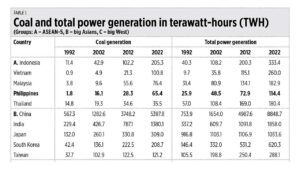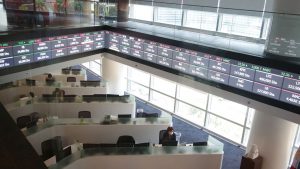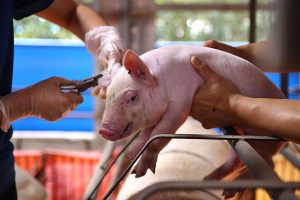A friend sent me a beautiful recent study, “Assessment of the Role of Coal in the ASEAN Energy Transition and Coal Phase-out,” published by the Jakarta-based ASEAN Energy Center (ACE) and guided by the ASEAN Forum on Coal (AFOC) and the ASEAN Secretariat. It is 58 pages long, released this May.
I checked my data to answer this question: What is the contribution of coal in the ASEAN, in Asia, and the industrial west?
Over the past three decades, 1992-2022, big countries in Asia including Japan were increasing their coal power generation while the US, Canada, Germany, and the UK had been downscaling their coal use. With this trend, the total power generation of the Asian nations jumped, like Vietnam, which went from 10 terawatt-hours (TWh) in 1992 to 260 TWh in 2022 or an expansion of 26 times; China, which went from 754 TWh in 1992 to 8,849 TWh in 2022, expanding by 11.7 times (see Table 1).
I computed the share of coal to total generation, then the average GDP growth of these countries over comparative years. The result shows that the use of coal in ASEAN-5 (Indonesia, Malaysia, the Philippines, Singapore, and Thailand) is rising, like Indonesia, which went from 28% in 1992 to 62% in 2022, and the Philippines, which rose from 7% to 57% over the same period. Thailand is the exception, with its share of coal declining from 26% to 20% as it began to use more gas, which is still a fossil fuel.
As the Asian nations used more coal as a cheap and stable source of energy for their modernization and industrialization, their average GDP growth was also high, ranging from 3% to 10% (except in Japan) from the 1990s to the 2010s. In contrast, the big western nations, with their declining shares of coal/total generation, saw low average growth, only 1% to 3% over the same period (see Table 2).
Here are some important points from the paper by ACE that I mentioned at the beginning of this column: “Relying primarily on the (International Energy Agency) IEA’s Net Zero Emission (NZE) Pathway as the Taxonomy’s foundation is also overly ambitious and not sufficiently tailored to the unique circumstances found in Southeast Asia…. After all, coal phase-out poses tremendous challenges for ASEAN due to the role of coal in providing sufficient energy supplies at the lowest cost possible, its contributions to the region’s economy… coal currently outperforms other energy sources in terms of supply security, reliability, affordability and — to some extent — sustainability in ASEAN’s power generation.”
MORE NONRENEWABLES NEEDEDThere were two energy reports of interest in BusinessWorld this week: “No red alerts projected in coming weeks — DoE” (June 9), and “AboitizPower says nonrenewables needed” (June 11).
During the Asia Clean Energy Forum (ACEF) on June 10 at the Asian Development Bank, one of the panel speakers was Carlos Aboitiz, the Chief Corporate Services Officer of Aboitiz Power Corp. He correctly pointed out that aside from “energy transition,” there is “another transition, a human one that aspires to lift people out of poverty and into modern society.”
Mr. Aboitiz argued — and I agree with him — that using the levelized cost of electricity (LCOE) only captures the cost of variable renewable energy (VRE) when the sources are available. But intermittency and lack of resources in solar and wind during different times of the day and year should also be considered and this should be reflected in a Levelized Full Cost of Electricity (LFCOE). The LFCOE incorporates the full costs of running the electrical grid reliably 24/7, hence it considers and includes the price and cost of technologies and capacities to fill the demand gap and minimize the intermittencies of VRE.
I particularly liked his concluding notes: “Lastly, we need to acknowledge when the narratives we use no longer serve us. The ‘renewable is hero and coal is evil’ narrative is no longer useful. It silences conversation about the need for a gradual transition and sacrifices understanding for the sake of convenience and comfort…. Holding all countries to the same standards is no longer useful. It ignores that imbalances in wealth, value, and responsibility that exist and this impedes climate politics from advancing.”
MERALCO FRANCHISE RENEWALOne important bill currently under deliberation in Congress is on the early renewal of Meralco’s franchise. See these recent reports in BusinessWorld: “MAP urges House to renew Meralco franchise” (May 31), “House told to fast-track hearings on Meralco’s franchise renewal bid” (June 2), “Makati Business Club backs Meralco franchise renewal” (June 5), and “Meralco ownership a ‘non-issue’” (June 9).
Aside from the Management Association of the Philippines (MAP) and the Makati Business Club (MBC), I read in other newspapers that there are five other groups and industry associations that have publicly endorsed an early renewal of Meralco’s franchise. These are: the Society of Philippines Electrotechnical Constructors & Suppliers, Inc. (SPECS), the Semiconductor and Electronics Industries in the Philippines Foundation, Inc. (SEIPI), the Philippine Iron and Steel Institute (PISI), the IT and Business Process Association of the Philippines (IBPAP), and the Advocates and Keepers Organization of OFW, Inc. (AKO OFW).
I also support this move for many reasons, but I will mention just one — Meralco’s Interruptible Load Program (ILP). This is the voluntary participation by large power users, like big manufacturing plants, to temporarily disconnect themselves from Meralco when the power supply is insufficient and reserve margins are thin and hence may lead to blackouts. Instead, they run their generator sets on diesel, and reconnect to Meralco later when the reserve margins have increased. They are later reimbursed for the higher generation cost of their diesel gensets.
There are two reasons why the ILP is very important.
One, it helps expand the power supply by up to 300 MW when the combined capacities of the gensets of many large companies are added, even temporarily, and hence helps avoid a bigger problem of rotating blackouts.
Two, it proves that the electricity price control at the Wholesale Electricity Spot Market (WESM) is bad and blackout-inducing. “Cheap but not available” electricity is wrong. Higher prices in the short-term are necessary to incentivize power producers to buy big oil gensets or build oil peaking plants to avoid blackouts and darkness, to avoid damaging the food in refrigerators, and damaging goods in manufacturing, etc.
Meralco should be commended for this innovation and it deserves a franchise renewal so it can further improve this program.
Meanwhile, the Philippine Chamber of Commerce and Industry (PCCI) will hold a Power Summit 2024 with the theme, “Moving the Economy Forward with Energy and Power Security and Competitiveness,” on June 19 at the Makati Diamond Residences. Among the speakers will be Consul Enunina V. Mangio, the President of PCCI; David Chua and George Barcelon, Chairs for Energy and Power of PCCI, Energy Secretary Raphael P.M. Lotilla, and Energy Regulatory Commission Chairperson and CEO Monalisa Dimalanta.
Bienvenido S. Oplas, Jr. is the president of Bienvenido S. Oplas, Jr. Research Consultancy Services, and Minimal Government Thinkers. He is an international fellow of the Tholos Foundation.






